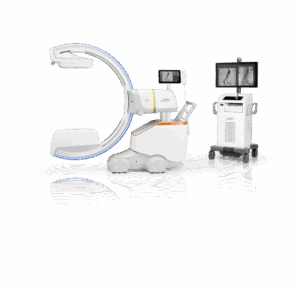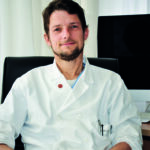This advertorial is sponsored by Siemens Healthineers.

Speaking to Michele Antonello (University of Padua, Padua, Italy) at the 2025 Charing Cross (CX) Symposium (23–25 April, London, UK), Nikolaos Tsilimparis (Ludwig Maximilian University Hospital, Munich, Germany) highlighted the benefits of a new robotic C-arm from Siemens Healthineers: Ciartic Move. Among several advantages, Tsilimparis underscored the system’s potential to reduce the workforce capacity needed during a procedure without compromising on image quality.
“The surgeon is in control”
One of the biggest challenges associated with a traditional C-arm, as highlighted by Antonello, is the difficulty for the whole team of manoeuvring the system into the operating room and positioning it correctly. “Everything is out of the operator’s control,” Antonello stressed, adding that these steps take up a significant amount of time for operating room staff.
“With Ciartic Move, the surgeon is in control,” Tsilimparis emphasised. He highlighted that this level of autonomy enables the operator to remain fully focused on the procedure, rather than becoming distracted by instructing staff unfamiliar with a particular C-arm on how to reposition it. In addition to streamlining workflow for the surgeon, he noted, it also saves valuable time for nurses and technicians. “That, in my opinion, is amazing,” he remarked.
Additionally, Tsilimparis mentioned that Ciartic Move can store up to 12 positions and be returned to a “parking position” at the end of a procedure, both of which save the operator and operating team even more time. “No scrub nurse has to stop providing you the instruments or materials that you need,” he explained, restating that this is “all done by the operator” with a remote control from the sterile field.
“High-quality” imaging

Aside from the workforce efficiencies brought by Ciartic Move, Antonello was keen to drill down on the imaging quality of the robotic system. He stated that this is usually “very high” in the lower limbs but questioned whether similarly top-grade imaging could be achieved in areas such as the carotid arteries and thoracoabdominal cavity.
“Ciartic Move is a high-quality imaging system,” Tsilimparis responded, referencing recent software adjustments Siemens Healthineers has made on the device that have improved its imaging offering.
Referencing his own experience with the C-arm, Tsilimparis continued that he and his team have used Ciartic Move in four fenestrated, three branched, and four thoracic endovascular aortic repairs (TEVARs) so far.
Tsilimparis was keen to place the imaging capabilities of Ciartic Move in the right context among available technologies. “If you already have a dedicated hybrid operating room with a mounted imaging system for all your procedures, this may not be necessary,” he acknowledged. “However, many centres around the world still don’t have that option. In those cases—where a mobile solution like a C-arm is required—this robotic C-arm comes remarkably close to the performance and precision of a fixed, mounted system,” he explained.
Tsilimparis pointed out that a robotic C-arm is “still one level below” a mounted system but is “certainly one level above the regular C-arms that we know”.
“Perfect option” for multispecialty use

Discussion then turned to the mobile nature of Ciartic Move, which allows it to be easily transported from one theatre to another. “If you have an emergency and cannot operate in your hybrid room at a particular time, you can easily go to any room and make a hybrid room with this system,” Tsilimparis said, emphasising that a robotic C-arm offers an institution “amazing flexibility” in terms of where and when procedures can be performed.
On this note, both Antonello and Tsilimparis mentioned how the benefits of Ciartic Move extend beyond the vascular surgery department. “Sometimes you need imaging on the first floor, sometimes on the second floor, and so I told my hospital that this device could be a great option, because you can have highquality images and move it easily,” Antonello shared, highlighting that the system can be used in vascular as well as in orthopaedic trauma, spine surgery and other departments.
Tsilimparis agreed, detailing that word spread fast in his institution—through departments ranging from orthopaedics to pulmonology and neurosurgery— about the benefits of the system. “If you are working in a setting where you need a C-arm that can be multidisciplinary and needs to move around the hospital from room A to room B to C to D, this is the perfect option,” he remarked.
Going into more detail about the system’s manoeuvrability, Tsilimparis provided an analogy for how the system works. “It resembles what we see on moon expeditions and how the robots on the moon work, which is really fascinating,” he said, underlining its ability to avoid collisions and be manoeuvred easily.
Device specifics
Homing in on some of the robotic C-arm’s key technical features, Tsilimparis highlighted a 3D computed tomography (CT) option. “It takes a little bit longer than a cone-beam CT with a mounted system,” he said, adding that combining 3D CT with an injection of contrast medium for vascular procedures might be a limitation; however, he emphasised that 3D CT without contrast to assess the condition and position of the stent graft post-implantation is “something that you can easily do”.
Closing the discussion, Antonello asked Tsilimparis to highlight the most important features of Ciartic Move that might convince colleagues to adopt the system in their institutions. “I think the most important thing for me is the ability of the surgeon to have full control during the procedure, that with a remote control you are able to take all of the positions you want, to move it up and down, just like you do with a mounted system, and that’s something that’s far and beyond all systems that are on the mobile C-arm market,” he responded.
Tsilimparis also reiterated that Ciartic Move ensures the nurses in the operating room have capacity to perform other tasks, pointing out that the acceptance rate among operating room staff is “extremely high”.
Finally, Tsilimparis underscored the quality of the imaging. He explained that this is based on traditional C-arm technologies from Siemens Healthineers, which are “known to offer some of the best imaging qualities among all the C-arms”.
Summarising his take on where Ciartic Move fits in the wider market, Tsilimparis stressed that the system offers several benefits to the operating team when compared to the alternatives of either a mounted system or a traditional C-arm. A robotic C-arm, he explained, “is closer to a mounted system in terms of quality of movement within the operating theatre than a traditional C-arm, while at the same time has all the flexibility that we get from the C-arm”.
Ciartic Move will not replace a mounted system, Tsilimparis put forward, but instead posited that it offers a strong alternative to “put you one or two levels above what you would have if you bought a regular C-arm”.
Disclaimer: The statements by Siemens Healthineers’ customers described herein are based on results that were achieved in the customer’s unique setting. Because there is no “typical” hospital or laboratory and many variables exist (e.g., hospital size, samples mix, case mix, level of IT and/or automation adoption) there can be no guarantee that other customers will achieve the same results.













